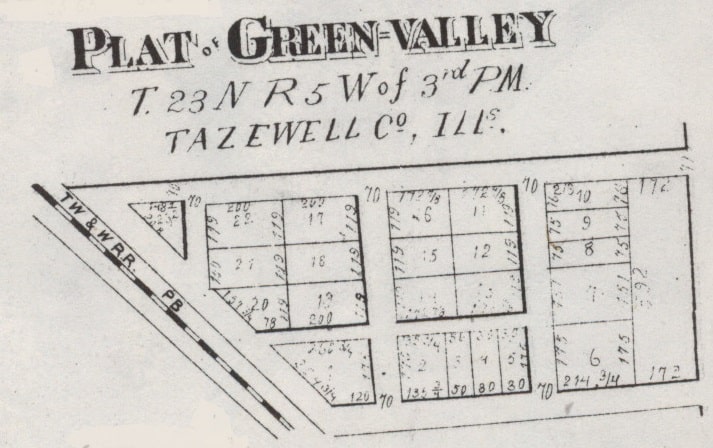Here’s a chance to read again one of our old Local History Room columns, first published in May 2013 before the launch of this blog . . .
Recently this column took a brief look at the history of Creve Coeur, one of Pekin’s neighbors to the north, with the help of a published village history in the Local History Room collection of the Pekin Public Library.
This week we’ll turn our attention to one of Pekin’s neighbors to the south, Green Valley, with the help of another published history in the Local History Room collection – the Green Valley quasquicentennial volume, “Green Valley, Illinois, Celebrates 125 Years, 1872-1997,” also titled, “Quasquicentennial: Green Valley, Illinois, 1872-1997.”
Green Valley is a small rural community in the south of Sand Prairie Township, not too far north of Malone Township. As a small rural community, its history naturally would not be limited to the families and events of the village, but would include the landowners and farmers in the surrounding area. Consequently, the quasquicentennial volume puts a spotlight not only on Green Valley, but also on Sand Prairie and Malone townships.
Small though it is, Green Valley is the largest community in Sand Prairie Township. Prior to the beginning of Green Valley’s history, however, the title of largest community in the township was held by the vanished village of Circleville. Sand Prairie Township originally was called Jefferson Township, and it used to be larger than it is today, encompassing parts of what is now Malone Township. Around 1824 – the year Jonathan Tharp built his log cabin at the future site of Pekin – white settlers first came to the future site of Circleville, in Section 1 of the former Jefferson Township.
“This was the first town in the township,” the Green Valley history says. “It was a stagecoach stop on the old stage line from Springfield to Pekin. As the inn was on rather high ground overlooking the Mackinaw bottom and surrounding prairie, when it came time for the stage to arrive the innkeeper would go upstairs, look out the window to see the coach, then rush downstairs to put potatoes on to boil for the meal. Another story was the open well where they used to cool the beer during the summer. One time someone placed the beer in a sack and when they went to draw it out of the well, the sack broke and the beer fell into the well.”
Circleville later became notorious as the favored hangout of the Berry Gang, a group of outlaws led by four brothers, William, Isaac, Emanuel and Simeon Berry, who had a homestead just outside of Circleville. The criminal career and ultimate doom of the Berry Gang is told in “Lynch Law,” a book authored by local historians and retired law enforcement officers Jim Conover and James Brecher.
An 1864 atlas map of Tazewell County shows Circleville in the northeast corner of Sand Prairie Township, but one will search in vain for Green Valley on that map. In 1864, the land that would become Green Valley was then the Dickson and Schureman farmsteads. (Other long-established and familiar family names of Sand Prairie Township include Woodrow, Deppert and Talbott. The wealthy Cummings family of Pekin also used to own land in the township.) Nine years later, the 1873 atlas map of Sand Prairie shows both Circleville and Green Valley. But visitors to Sand Prairie Township today will find no trace of Circleville, which slowly dwindled away after the heyday of the Berry Gang.
“The land where Green Valley now stands was purchased from the government in 1852 by Samuel Schureman for $3 an acre,” the Greek Valley history says. “He built a one-room house on the side of the present Schureman homestead. Another house was where the 1912 grade school was later built. A Schureman tale is told of the days when wild game ran through the prairie grass and prairie chickens were so thick that when they flew to roost in the evenings on the rail fences, the rail could not be seen for the number of chickens covering it.”
On Oct. 19, 1872, the unincorporated village of Green Valley was platted out by Samuel Schureman. The little settlement’s development was anchored by the Illinois Central Railroad, which was built in 1870, and the Smith-Hippen grain elevator, which was built in 1872. The village celebrated its centennial in 1972, commemorating the original platting by Samuel Schureman, but another centennial milestone is only three years away: March 11, 2016, will be exactly 100 years from the date Green Valley was incorporated as a village.
The community formerly boasted its own newspaper, the Green Valley Banner, which was founded by Clark Nieukirk in the late 1890s and which continued to be printed until it fell victim to the Great Depression in the 1930s. Microfilms of the Green Valley Banner from July 15, 1897, to Dec. 28, 1922, are available in the Pekin Public Library’s Local History Room.











